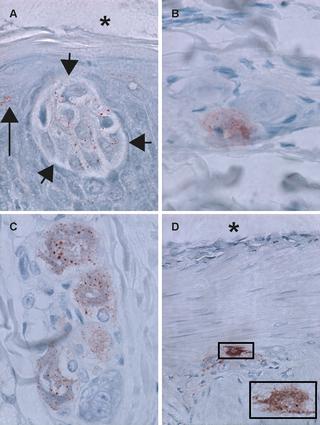PLOS Neglected Tropical Diseases ( IF 3.4 ) Pub Date : 2018-03-05 , DOI: 10.1371/journal.pntd.0006311 Richard Suu-Ire , Lineke Begeman , Ashley C. Banyard , Andrew C. Breed , Christian Drosten , Elisa Eggerbauer , Conrad M. Freuling , Louise Gibson , Hooman Goharriz , Daniel L. Horton , Daisy Jennings , Ivan V. Kuzmin , Denise Marston , Yaa Ntiamoa-Baidu , Silke Riesle Sbarbaro , David Selden , Emma L. Wise , Thijs Kuiken , Anthony R. Fooks , Thomas Müller , James L. N. Wood , Andrew A. Cunningham

|
Rabies is a fatal neurologic disease caused by lyssavirus infection. People are infected through contact with infected animals. The relative increase of human rabies acquired from bats calls for a better understanding of lyssavirus infections in their natural hosts. So far, there is no experimental model that mimics natural lyssavirus infection in the reservoir bat species. Lagos bat virus is a lyssavirus that is endemic in straw-colored fruit bats (Eidolon helvum) in Africa. Here we compared the susceptibility of these bats to three strains of Lagos bat virus (from Senegal, Nigeria, and Ghana) by intracranial inoculation. To allow comparison between strains, we ensured the same titer of virus was inoculated in the same location of the brain of each bat. All bats (n = 3 per strain) were infected, and developed neurological signs, and fatal meningoencephalitis with lyssavirus antigen expression in neurons. There were three main differences among the groups. First, time to death was substantially shorter in the Senegal and Ghana groups (4 to 6 days) than in the Nigeria group (8 days). Second, each virus strain produced a distinct clinical syndrome. Third, the spread of virus to peripheral tissues, tested by hemi-nested reverse transcriptase PCR, was frequent (3 of 3 bats) and widespread (8 to 10 tissues positive of 11 tissues examined) in the Ghana group, was frequent and less widespread in the Senegal group (3/3 bats, 3 to 6 tissues positive), and was rare and restricted in the Nigeria group (1/3 bats, 2 tissues positive). Centrifugal spread of virus from brain to tissue of excretion in the oral cavity is required to enable lyssavirus transmission. Therefore, the Senegal and Ghana strains seem most suitable for further pathogenesis, and for transmission, studies in the straw-colored fruit bat.
中文翻译:

天然水库中蝙蝠狂犬病的发病机制:稻草色果蝠(Eidolon helvum)对三株拉各斯蝙蝠病毒的敏感性比较
狂犬病是由狂犬病病毒感染引起的致命性神经系统疾病。人们通过与被感染的动物接触而被感染。从蝙蝠中获得的人类狂犬病相对增加,要求人们更好地了解其自然宿主中的狂犬病病毒感染。到目前为止,还没有实验模型可以模拟水库蝙蝠物种中的天然狂犬病病毒感染。拉各斯蝙蝠病毒是一种狂犬病病毒,是稻草色果蝠(Eidolon helvum) 在非洲。在这里,我们通过颅内接种比较了这些蝙蝠对三种拉各斯蝙蝠病毒(来自塞内加尔,尼日利亚和加纳)的敏感性。为了进行菌株之间的比较,我们确保将相同滴度的病毒接种在每个蝙蝠的大脑相同位置。所有蝙蝠(每株n = 3)均被感染,并发展为神经系统症状,致命的脑膜脑炎伴有狂犬病病毒抗原在神经元中表达。各组之间存在三个主要差异。首先,塞内加尔和加纳组的死亡时间(4至6天)明显短于尼日利亚组的死亡时间(8天)。第二,每种病毒株产生不同的临床综合征。第三,通过半巢式逆转录酶PCR检测病毒向周围组织的扩散,在加纳组中很常见(3蝙蝠中的3个)并且分布广泛(在所检查的11个组织中有8到10个组织呈阳性),在塞内加尔组中很常见,分布不那么广泛(3/3蝙蝠,有3到6个组织呈阳性),并且在尼日利亚组中罕见且受限制(1/3蝙蝠,2个组织阳性)。为了使狂犬病病毒能够传播,需要病毒从脑向口腔中的排泄组织进行离心扩散。因此,塞内加尔和加纳的菌株似乎最适合于进一步的发病机理,以及在稻草色果蝠中进行传播的研究。需要病毒从脑向口腔中排泄组织的离心传播,以实现狂犬病病毒的传播。因此,塞内加尔和加纳的菌株似乎最适合于进一步的发病机理,以及在稻草色果蝠中进行传播的研究。为了使狂犬病病毒能够传播,需要病毒从脑向口腔中的排泄组织进行离心扩散。因此,塞内加尔和加纳的菌株似乎最适合于进一步的发病机理,以及在稻草色果蝠中进行传播的研究。











































 京公网安备 11010802027423号
京公网安备 11010802027423号